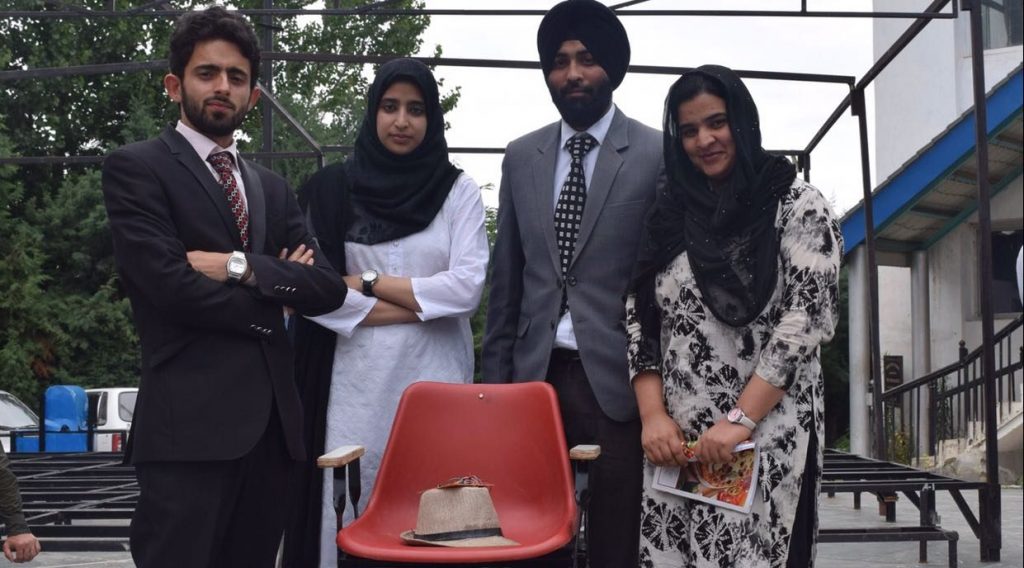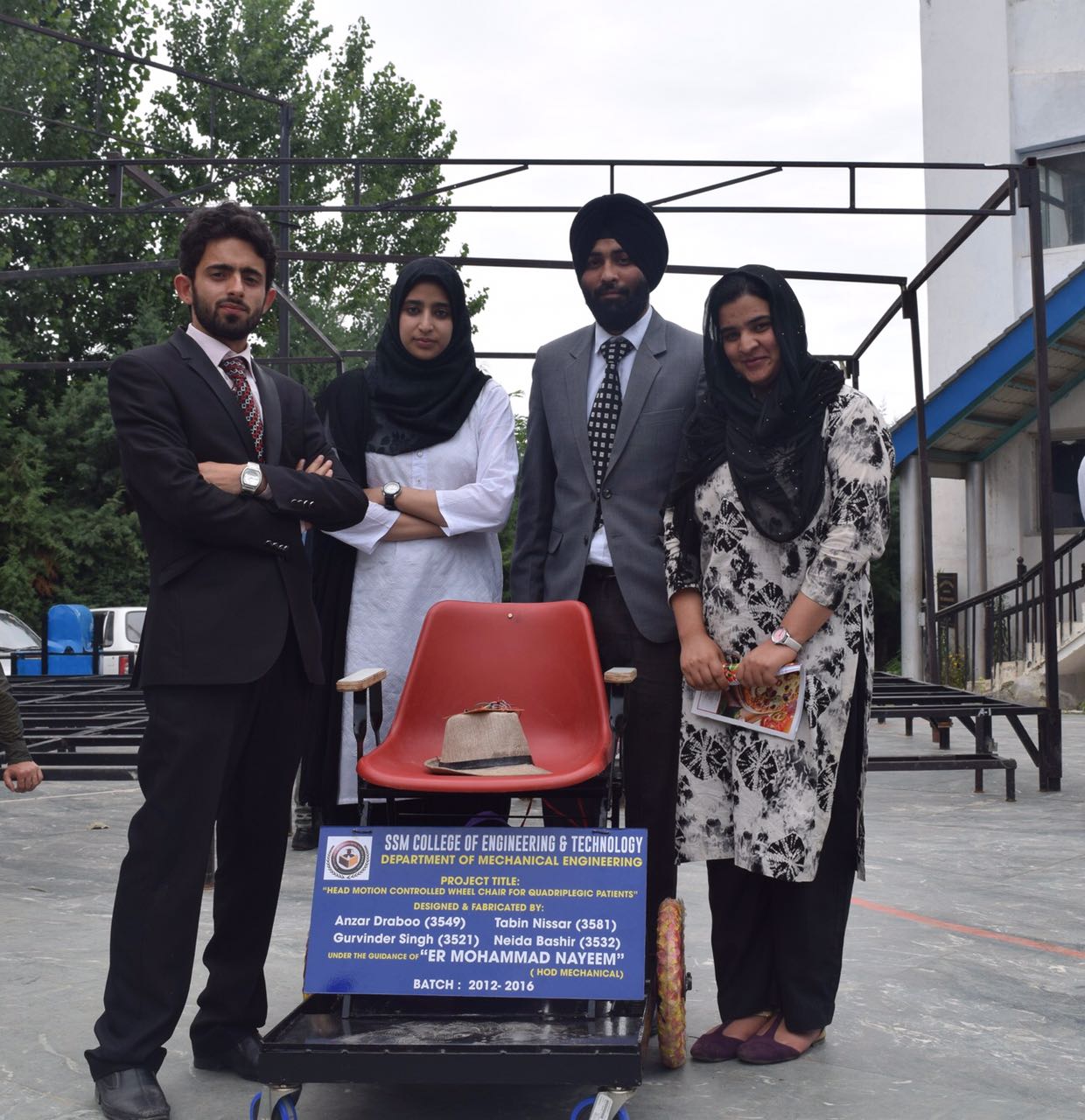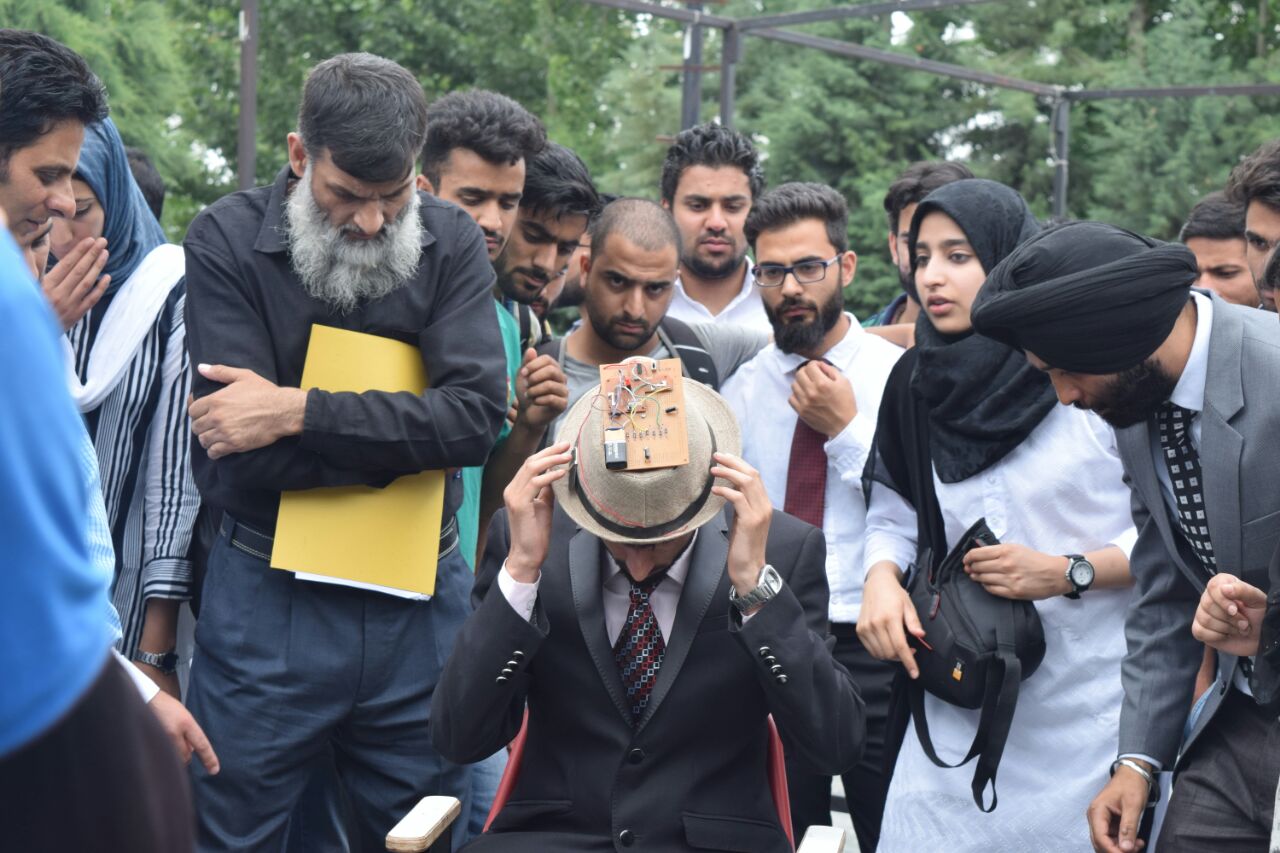Blog, Inspiring Kashmiris, People, Z
Meet These Kashmiris Who Have Designed Head Motion Wheel Chair For Quadriplegic Patients
Interview by Sidra Nazir from Gyawun
Tell us about yourself and your team?
I am Anzar Draboo from Rawal Pora, Srinagar. I have done my schooling from Burn Hall Higher Secondary School. Since my childhood, I was always fascinated by the machines and technology. I did my Engineering from SSM College Of Engineering & Technology.
My team comprised of the following people: Gurvinder Singh, Tabin Nisar and Nida Bashir. It was the combined team effort that led to the prototype of the contraption. I am indebted to them and it would have been impossible to convert my ideas into the reality. The best teamwork comes from people who are working independently towards one goal in unison. Everyone in my team had a particular task to accomplish and thankfully with all the relentless hard work the chair was finally fabricated.
Tell us about the project ‘Head Motion Wheel Chair’
Rehabilitation Engineering is the application of engineering principles and technology in the field to uplift the people with disabilities. This wheelchair is designed for the quadriplegic patients.
Tetraplegia, also known as quadriplegia, is paralysis caused by illness or injury that results in the partial or total loss of use of all four limbs and torso; paraplegia is similar but does not affect the arms. The loss is usually sensory and motor, which means that both sensation and control are lost. Tetraparesis or quadriparesis, on the other hand, means muscle weakness affecting all four limbs. It may be flaccid or spastic. The extent of the injury is also important. A complete severing of the spinal cord will result in complete loss of function from that vertebra down. A partial severing or even bruising of the spinal cord results in varying degrees of mixed function and paralysis. A common misconception with tetraplegia is that the victim cannot move legs, arms or any of the major function; this is often not the case. Some individuals with tetraplegia can walk and use their hands, as though they did not have a spinal cord injury, while others may use wheelchairs and they can still have the function of their arms and mild finger movement; again, that varies on the spinal cord damage. Tetraplegia is caused by damage to the brain or the spinal cord at a high-level C1–C7—in particular, spinal cord injuries secondary to an injury to the cervical spine. The injury, which is known as a lesion, causes victims to lose partial or total function of all four limbs, meaning the arms and the legs. Tetraplegia is defined in many ways; C1–C4 usually affects arm movement more so than a C5–C7 injury; however, all tetraplegics have or have had some kind of finger dysfunction.
We have designed a tilt communicator system for the quadriplegic patient who is suffering from damage to the spinal cord. The tilt communicator is designed with artificial intelligence and embedded to provide a communication between the patient and the wheelchair through the tilt of the head. The digital output produced (0 or 1) based on specified tilt of the head movement viz. front, back, left or right is made available to the RF transmitter as an input using the logic designed with the help of diodes and relays for the four respective directions of controlling. An RF receiver system using 434 MHz frequency oscillator is used at the receiver station that provides a real-time controller to the wheelchair to control the motion in the desired direction by calculating the intended direction of the head movement.
Based on these variations and the diode logic the movement of the wheelchair in a particular direction is attained.
1. When person tilts his head in forward direction, the chair
will move in forward direction.
2. If person tilts his head in the backward direction, chair
will move in the backward direction.
3. If person tilts his head in the left direction, the chair will
move in left direction.
4. If person tilts his head in right direction, the chair will
move in right direction.
What is the main aim of the project?
Mobility has become very important for a good quality of life. Loss of mobility due to an injury is usually accompanied by a loss of self-confidence. Designing a system with independent mobility for such disabled people is our aim in this project. Statistics show us that 43 million are disabled, about 17% of 250 million; almost 1 out of 5 persons are disabled. 52% of spinal cord injured individuals are considered paraplegic and 47% quadriplegic. The idea behind this project is to design a tilt communicator system for a handicapped person who is suffering from spinal cord injury those who could not move their hands as well as legs. Quadriplegics are limited in their motion and need some device to communicate with their wheelchair for mobility without others assistance providing the quadriplegics with movement and help them to be more independent is the main aim of the project. The idea is to design a new human-machine interface for controlling a wheelchair by head movements. Our project can be used by not only quadriplegics but also by all those who are mobility impaired. This system is an automatic head tilt movement controlled wheelchair that could operate in any direction using head movements i.e. forward, backward, left and right. It stops when the person does not tilt his head in any direction.
So, our main design focus was to reduce the cost by including lower cost components, making the design simple by avoiding the use of highly complex programmable ICs and making more effective gesture-based control by head tilt movements for physically impaired persons. The available designs for automatic and gesture-based wheelchairs are designed using microcontrollers and their programming, but our design incorporates very basic analog and digital circuits to avoid the complexity and cost issue. Also, we have employed tilt sensors in place of accelerometers to make the design simple and robust.
What bottlenecks did you face in the making of this project
It took us about 7 months to make this wheelchair. The entire journey was full of challenges. There were many bottlenecks which we faced during the making of this chair. The major hindrance was the turmoil of 2016. There was an internet and communication clampdown and therefore we had no access to the internet or any other source of information. And then secondly the availability of the material that we needed for this chair troubled us. Due to the communication gag, we were not able to contact any of the teammates.
Due to the unending curfew, we were not able to meet our project guide. Since our wheelchair had too much electronic integration and this being beyond our area of expertise caused several hitches.
Another major impedance was the funding. We couldn’t make what we actually planned to make as it required a huge amount of money. There was no source of funding and then we redesigned the wheelchair to make it much more economically viable. We planned to drop several ideas due to the financial limitations but we didn’t want to compromise on the design. Finally, we made this wheelchair as per the new design.
How can people have access to your wheelchair
Right now people cannot have access to this wheelchair as we are not into production yet. Thanks to almighty it has succeeded as a prototype.
We never thought we would get such an overwhelming response and that too in the initial phase of its making. So far we have already received 3 orders for this prototype. I feel blessed that we are able to serve to the people of my state. I believe that a lot more has to be done on this wheelchair.
We are planning to extend our project by using the heartbeat sensors. Heartbeat sensor continuously monitors the heart rate, which can be designed such that alarm horns if the heart level goes beyond a set level.
We can make a wheelchair which can be operated by a wireless remote. The output of the sensor can be applied to the wireless transmitter circuit and can be received at wheelchair circuit by receiver circuitry. So wireless operation can reduce wiring arrangements.
Instead of using acceleration motion (Head Movement) we can use eye retina using an optical sensor to move the wheelchair in a different direction. Using retina movement we would be able to drive a wheelchair. We can use voice command IC to interface our voice signals with the microcontroller. The voice stored in IC could be sufficient to analyze speakers voice Command. By including GPS, the position of the wheelchair can also be known. The designed wheelchair can be extended using solar panels which is more efficient. Solar panel itself energizes the wheelchair and there will be no need to charge the wheelchair again and again. Before commercializing this product we want to incorporate some of the safety features. In Sha Allah, we believe that this product will help in providing the independence to the quadriplegic patients.



